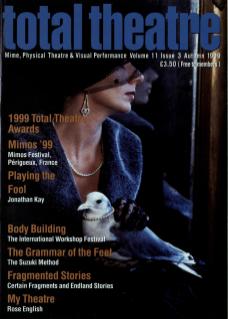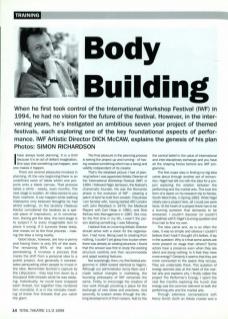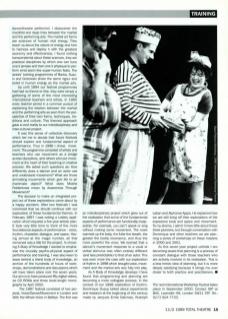I have always loved planning. It is a thrill because it is an act of defiant imagination. One says that something can happen, and one makes it happen.
There are several pleasures involved in planning. At the very beginning there is an undefined swim of ideas which one projects onto a blank canvas. That process takes a while – weeks, even months. The next stage is sudden. An idea comes to you from nowhere. It can happen while walking (Nietzsche only believed thoughts he had whilst walking), on the lavatory (Tadeusz Kantor considered the lavatory as a special place of inspiration), or in conversation. Having got the idea, the next stage is to subject it to every imaginable test to prove it wrong. If it survives these tests, one moves on to the final process – making the idea a living reality.
Good ideas, however, are two-a-penny and having them is only 5% of the work. The remaining 95% of the work is painstaking. It involves a process that marks the shift from a personal idea to a public project. And generally it necessitates persuading other people to invest in the idea. Remember Gulliver's capture by the Lilliputians: they tied him down by a thousand little threads while he was sleeping. Individually, he could have snapped each thread, but together they rendered him immobile. It is in the intricate meshing of these fine threads that you catch the giant.
The final pleasure in the planning process is seeing the project up and running – of having created something which has a being and validity independent of its creator.
That's the idealised picture I had of planning before I was appointed Artistic Director of the International Workshop Festival (IWF) in 1994. I followed Nigel Jamieson, the festival's charismatic founder. His was the Romantic phase in the evolution of IWF – clearing a patch of land he built from scratch. This phase I am familiar with, having started ATC London with John Retallack in 1979; the Medieval Players with Carl Heap in 1981; and Dick McCaw Arts Management in 1987. But now, for the first time in my life, I wasn't the person starting something, I was following.
I believe that an incoming Artistic Director should arrive with a vision for the organisation. I had none. Being used to creating from nothing, I couldn't yet grasp how to plan when there was already an existing structure. I found that the answer was first to study the existing structure carefully and then accommodate and adapt existing features.
Not surprisingly, then, my first festival programme in 1994 looked identical to Nigel's. Although our administrator Jenny Klein and I made radical changes in marketing, the founding philosophy of IWF remained the same. Firstly, to encourage the creation of new work through providing a place for the exchange of new ideas and practices. And secondly, to sustain artists through the lifelong development of their careers. Add to this the central belief in the value of international and interdisciplinary exchange and you have all the shaping forces behind any IWF programme.
The first major step in finding my big idea came about through another act of reinvention. Nigel had left me with the idea for a project exploring the relation between the performing and the martial arts. This took the form of a report on his research trip to Kerala, South West India, in Spring 1992. While Nigel clearly saw a project here, all I could see were facts. At the heart of a project there has to be a burning question that demands to be answered. I couldn't discover (or couldn't empathise with?) Nigel's burning question and thus had to find my own.
The idea came and, as is so often the case, it was so simple and obvious I couldn't believe that I hadn't thought of it before. It lay in the question: Why is it that some actors are more present on stage than others? Some actors have a presence even when they are silent and doing nothing. Is it that they have more energy? Certainly it seems that they are more connected to the space they occupy. They are undeniably there. This question of energy seemed also at the heart of the martial arts and explains why I finally called the project The Performer's Energy. I spent the next few months exploring the hunch that energy was the common element to both the performing arts and the martial arts.
Through extensive conversations with Henry Smith (both an Aikido master and a dance/theatre performer) I discovered the manifold and deep links between the martial and the performing arts. The martial art forms are sciences of human vital energy. They teach us about the nature of energy and how to harness and deploy it with the greatest economy and effectiveness. I found nothing transcendental about these sciences, they are practical disciplines by which one can tune one's senses and train one's physique to perform what seem like superhuman feats. The actors training programmes of Barba, Suzuki and Grotowski share the same rigour and belief in human energy as the martial arts.
Up until 1994 our festival programmes had had no theme or title, they were simply a gathering of some of the most interesting international teachers and artists. In 1995 every teacher joined in a common pursuit of explaining the relation between the martial and the performing arts as seen from the perspective of their own forms, techniques, traditions and culture. This themed approach gave a vivid reality to our interdisciplinary and intercultural project.
It was this sense of collective discovery which led me to decide that future festivals should explore one fundamental aspect of performance. Thus in 1996 I chose movement. The programme consisted of artists and teachers who use movement as a bridge across disciplines, and others who put movement at the heart of their teaching or creative process. We asked such questions as: How differently does a dancer and an actor use and understand movement? What are those animating movements which give life to an inanimate object? What does Moshe Feldenkrais mean by Awareness Through Movement?
The decision to make an integrated project out of these explorations came about by a happy accident. After two festivals I was convinced that we should continue with our exploration of these fundamental themes. In February 1997 I was writing a Lottery application which required a five-year artistic plan. It took very little time to think of five more foundational aspects of performance – voice, rhythm, character, dialogue, and space. Having arrived at the magic number, all that remained was a title for the project. In choosing A Body of Knowledge I wanted to emphasise the crucially psycho-physical aspect of performance and training. I was also keen to leave behind a literal body of knowledge, an archive of the hundreds of hours of workshops, demonstrations and discussions which will have taken place over the seven years. Our aim is to have produced fifty digital videos, six CD ROMs and three book-length monographs by April 2002.
The 1997 festival consisted of two projects, Voice/Dance/Movement in London and With the Whole Voice in Belfast. The first was an interdisciplinary project which grew out of the realisation that some of the fundamental aspects of performance are functionally inseparable. For example, you can't speak or sing without making some movement. The more warmed-up the body, the fuller the breath, the greater the bodily resonance, and thus the more powerful the voice. We learned that a dancer's movement response to a vocal or verbal stimulus was often entirely different (and less predictable) to that of an actor. This was even more the case with our exploration of rhythm in 1998 which brought voice, movement and the martial arts very fully into play.
As A Body of Knowledge develops I have found that programming and planning are becoming a more collegiate process. In the context of our 1998 exploration of rhythm, Dominique Dupuy talked about experiments and research at the beginning of this century made by Jacques Emile Dalcroze, Rudolph Laban and Alphonse Appia. He explained how we are still living off their explorations of the expressive body and space and movement. To my shame, I admit I knew little about these three pioneers, but through conversation with Dominique and other teachers we are planning a series of workshops on these masters in 2000 and 2001.
As this seven-year project unfolds I am becoming aware that planning is a process of constant dialogue with those teachers who are actively involved in its realisation. This is a less heroic idea of planning, but it is more deeply satisfying because it brings me ever closer to both practice and practitioners.
The next International Workshop Festival takes place in September 2000.


